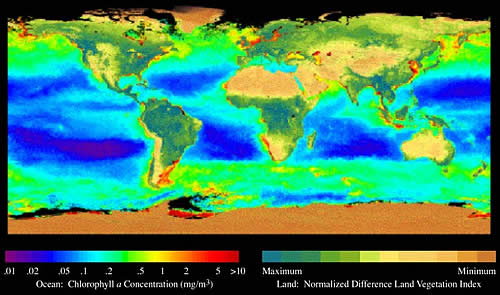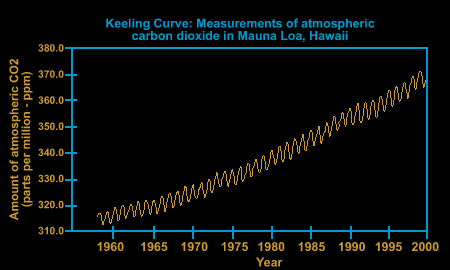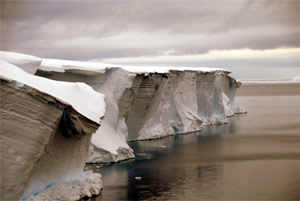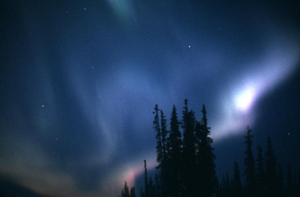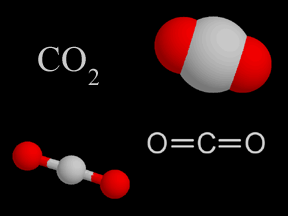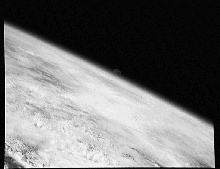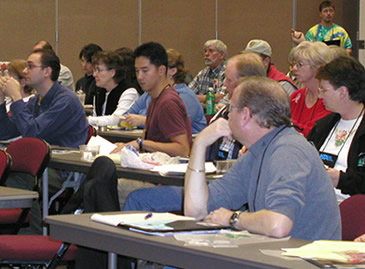The Biosphere: An Integral Part of the Planet and its Climate
|
Traditionally, Earth science classes and textbooks have focused on the non-living parts of the Earth (rocks and minerals, oceans, freshwater, ice, and the atmosphere). With the exception of living things that were fossilized long ago, life may not get much, if any, mention, even through it has an enormous impact on the planet. However, recently the impact of all the living things on our planet, known collectively as the biosphere, has garnered great attention as the biosphere’s connection to global climate has become increasingly apparent and critical. In explanation of why the science of Earth’s climate had historically been neglected, scientist James Lovelock faulted the disconnect between the way living components of Earth are studied and the way non-living components of Earth are studied - that biologists, “failed to see that living things were tightly coupled to their material environment and that evolution concerns the whole Earth system with living organisms an integral part of it.” While the term “biosphere” was first coined over eighty years ago by Russian scientist Vladimir I. Vernadsky, thorough study of the biosphere’s interactions with the rest of the planet has happened mainly in the past few decades, since awareness of Earth as a system has grown in the scientific community. For hundreds of years people have recognized some of the connections between living things and climate, cutting down the trees of a forest can change the temperature of the immediate area for example, however the complex interrelationships between the biological and physical parts of the Earth system were not well understood until Charles Keeling began making detailed measurements of the amounts of carbon dioxide in the atmosphere over time. In the 1960s, the connection between rising atmospheric carbon dioxide and global warming was becoming clear and scientists began actively exploring the details of how carbon got into and out of the atmosphere via, largely, biological processes. Dr. Charles Keeling began making his now-famous measurements of carbon dioxide in the atmosphere in 1958 from the top of Mauna Loa in Hawaii. Before Keeling began taking measurements, we didn't know was that the collective efforts of all the land plants in the Northern Hemisphere as they wake up from their winter slumber and start to photosynthesize affects the atmosphere worldwide. In just a short amount of time, a fraction of a year, plants change the world. That is, before they once again drop their leaves and head back into dormancy. When it is spring and summer in the Northern Hemisphere, more plants are around to photosynthesize and extract carbon from the atmosphere, the amount of carbon dioxide decreases by about 3%. When it is autumn and winter in the Northern Hemisphere, there are fewer plants doing photosynthesis, so more carbon dioxide in the atmosphere. This is a natural fluctuation. Keeling's data tell another story too. At the close of each year, the carbon dioxide levels are a bit higher than they were the year before. The yearly wobbles caused by plant photosynthesis look like they are heading uphill on the graph because of an increase in carbon dioxide over several decades. These data were the first concrete evidence that the amount of carbon dioxide has been increasing. This overall rise in the amount of carbon dioxide in the atmosphere is due to human impacts on the planet - mainly burning fossil fuels. The graph of Keeling's carbon dioxide data became known as the "Keeling Curve" and continues to serve as an illustration of the impact of the biosphere on the atmosphere, and the consequences in terms of global warming. The Gaia Hypothesis, developed by James Lovelock in the 1970s, emphasized the importance of the biosphere on the regulation of Earth’s climate. Lovelock’s scientific research focused on how the Earth’s atmosphere was affected by the biosphere. The main tenet of the Gaia Hypothesis is that our planet is analogous to a single cell – everything it has or could need is contained within the cell aside from energy that comes in from the Sun. Taken too literally, this may sound completely absurd. However, the general idea of Earth as a contained system is now widely accepted. This idea of Lovelock’s dovetails well with the idea, formulated about a decade later in the 1980s, of Earth system science, that the parts of our planet are interconnected in a multitude of ways. Today, interdisciplinary research combining biochemistry, geochemistry, biology, hydrology, and atmospheric science helps us to better understand the biosphere’s role in the Earth system and, in particular, how biogeochemical cycles affect the Earth system. This understanding of the biosphere forms part of the framework utilized by supercomputer models, which describe and predict the Earth’s climate. In this week of the course we will examine the Earth’s biosphere and how changes in the cycling of carbon and nitrogen between the living and non-living parts of the Earth system are causing changes in climate. We will also find out how Earth’s warming climate is affecting aspects of the biosphere. This week’s classroom activity will put your students into the nitrogen cycle, and an online interactive will allows them to surf through the carbon cycle. We will also discuss carbon credits, a topic of current debate among scientists, social scientists, and policy makers.
|


